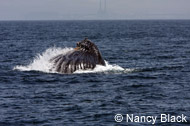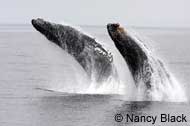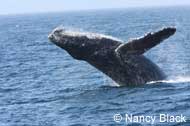 The
spring and summer of 2008 in Monterey Bay have been exceptional for the
numbers of humpback whales feeding in the Bay. Over the last few months
40-60 whales have been feeding on massive schools of anchovies within
a few miles of the Monterey Harbor. Along with the whales, thousands of
California sea lions, harbor seals and seabirds are also congregating
to gorge themselves on the fish. In addition, on some days thousands of
dolphins, including Pacific white-sided dolphins, northern right whale
dolphins, and Risso's dolphins have been sighted along the edge of the
Monterey Submarine Canyon feeding on more fish and squid over these deeper
waters. Killer whales have periodically cruised through the area, some
staying for several days to hunt the seals and seal lions. This all has
resulted in a season of extraordinary whale watching and we expect this
to continue through summer and fall as ocean conditions this year are
ideal to support this massive food source in the Bay. The
spring and summer of 2008 in Monterey Bay have been exceptional for the
numbers of humpback whales feeding in the Bay. Over the last few months
40-60 whales have been feeding on massive schools of anchovies within
a few miles of the Monterey Harbor. Along with the whales, thousands of
California sea lions, harbor seals and seabirds are also congregating
to gorge themselves on the fish. In addition, on some days thousands of
dolphins, including Pacific white-sided dolphins, northern right whale
dolphins, and Risso's dolphins have been sighted along the edge of the
Monterey Submarine Canyon feeding on more fish and squid over these deeper
waters. Killer whales have periodically cruised through the area, some
staying for several days to hunt the seals and seal lions. This all has
resulted in a season of extraordinary whale watching and we expect this
to continue through summer and fall as ocean conditions this year are
ideal to support this massive food source in the Bay.
It's been over two years since strong upwelling conditions have occurred
in the Bay. Strong northwest winds that have been periodically blowing
along our coast have created ideal conditions for upwelling - in which
deep water filled with nutrients is driven to the surface by a combination
of the winds, currents, contour of the coastline and the rotation of the
earth. The nutrients hit the surface and the sun fuels the production
of plankton blooms, which supports the fish and all the animals that depend
on these anchovies and sardines for food, especially the humpback whales.
 These
oceanographic conditions are also ideal for the reproduction and concentration
of krill, which usually occurs later in the summer and fall; a situation
ideal for blue whales, the largest animal on earth. Due to poor upwelling
conditions and timing over the last few years, blue whales have been feeding
elsewhere but we predict this year Monterey Bay should be full of krill
and hopefully many blue whales. Blue whales feed only on krill, a small
shrimp-like animal that congregates in huge masses. An adult blue whale
eats about 4 tons of krill a day, or 40 million individual krill! Humpback
whales feed on both fish and krill and are currently concentrating in
Monterey Bay in huge numbers. These
oceanographic conditions are also ideal for the reproduction and concentration
of krill, which usually occurs later in the summer and fall; a situation
ideal for blue whales, the largest animal on earth. Due to poor upwelling
conditions and timing over the last few years, blue whales have been feeding
elsewhere but we predict this year Monterey Bay should be full of krill
and hopefully many blue whales. Blue whales feed only on krill, a small
shrimp-like animal that congregates in huge masses. An adult blue whale
eats about 4 tons of krill a day, or 40 million individual krill! Humpback
whales feed on both fish and krill and are currently concentrating in
Monterey Bay in huge numbers.
The humpback whales have been feeding in groups of 15 to 20 whales around
some of these fish schools. With so many whales in the area, they often
become social and very active, often breaching, tail slapping, fin slapping,
and sometimes becoming curious about us as they approach and hang next
to the boat while we just drift in one spot. The numbers and antics of
these whales have more than thrilled passengers. On one recent day, we
watched as one whale breached over 300 times in a row, then alternated
pec slapping (rolling on their side and slapping their long side flipper
against the water) with the breaches (jumping completely out of the water).
If the fish are near the surface, the whales will lunge feed up through
the surface, engulfing the fish with their mouths wide open and some anchovies
spilling out.
Humpback whales are still endangered, as they were heavily hunted at
one time even in Monterey Bay, which was a historic feeding area for them.
Since they have been protected for over 30 years now their population
has greatly increased. Currently there are about 1,400 humpback whales
that feed off California and migrate to Mexico during the winter to have
their calves and mate. In fact the population is growing about 6% each
year and we are seeing more calves this year in the Bay then in all previous
years.
 If
you haven't been out before now is the time to go, as this season is definitely
the best in many years. In fact on some days whales have been very close
to the Monterey shoreline and on these days can easily be seen from shore,
or just by looking out a bit farther you can often see many blows or splashes
in the Bay. We have taken thousands of photos of the active humpbacks
and the photos included here were taken in the last few weeks. We also
continue to individually identify the whales by the markings on the underside
of the tail flukes and contribute those identifications to Cascadia Research,
which compiles all the photos and determines a population estimate for
these whales each year. If
you haven't been out before now is the time to go, as this season is definitely
the best in many years. In fact on some days whales have been very close
to the Monterey shoreline and on these days can easily be seen from shore,
or just by looking out a bit farther you can often see many blows or splashes
in the Bay. We have taken thousands of photos of the active humpbacks
and the photos included here were taken in the last few weeks. We also
continue to individually identify the whales by the markings on the underside
of the tail flukes and contribute those identifications to Cascadia Research,
which compiles all the photos and determines a population estimate for
these whales each year.
For recent information see our daily sightings
or to make a reservation go to our secure
reservation form or call us at 831-375-4658.
|
|
![]()
![]()
